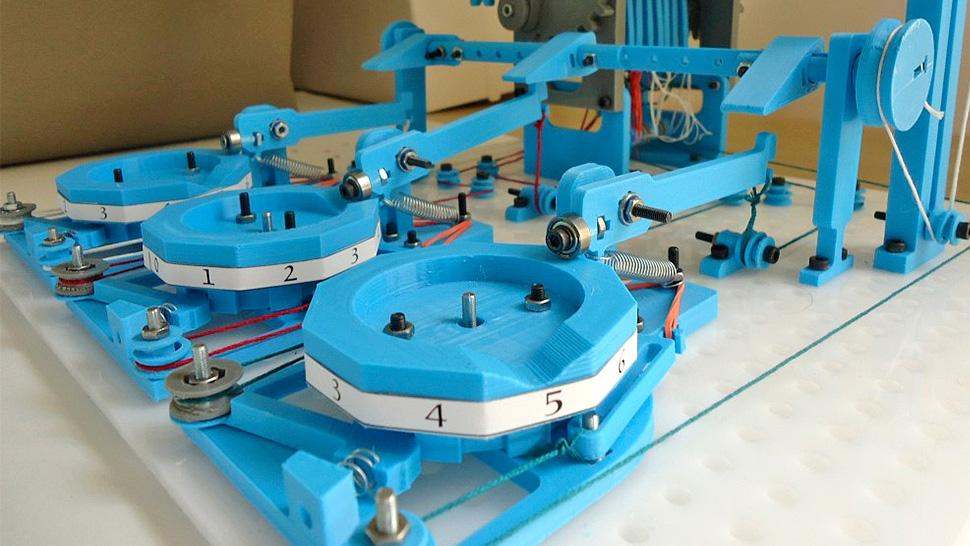“Have you ever been sitting there, quietly computing something and thinking to yourself, “If only this process were somehow billions of times slower, less reliable, and involved lots of physical labor”? If so, the Turbo Entabulator is the machine you’ve been looking for,” says Chris Fenton.
Chris Fenton, a NYC electrical engineer who builds supercomputers at work by day, has in his free time built yet another 3D printed mechanical computer. In a wonderfully ironic mix of new and older (we’re talking seriously older) technological concepts, the Turbo Entabulator is composed of nearly all 3D-printed parts, except for some nuts and bolts, several springs, rubber bands, and some tiny bearings. Eschewing smart parts and modern electronic components, Fenton instead prefers to use parts such as levers and gears.
The Entabulator is an improved sequel to his 3D-printed FIBIAC, an electromechanical punch card reader that “chugs along at nearly one micro-operation-per-second.” His original plan before the Entabulator was to build a weaving loom inspired by a tome he read, circa 1895, titled The Mechanism of Weaving. It proved to be inestimably difficult though and he scrapped the project in favor of the the Entabulator, which is a “reliable, 3D-printable 10-hook punch card reader.”
With the Entabulator, Fenton wanted to go even slower and more mechanical, using no electronics this time, but with the same principles he used with FIBIAC–a set of registers that can be selectively incremented/decremented until a selected register reaches zero.
After much trial and error with his first project, Fenton had the good fortune to acquire a Makerbot Thing-o-matic, which he says is “just ridiculously easier to prototype with than anything I’ve worked with before.” As with the latest machine, his first was also constructed nearly completely out of 3D-printed parts from the Thing-o-Matic.
“I also figured out a way to use spring-loaded pins and punch-cards to read the instruction stream rather than my infrared card-reader, making the machine drastically simpler and getting rid of fifty percent of the electronics it initially needed, as well as significantly upping the machine’s geeky street-cred,” says Fenton.
After 20 or so initial trials, Fenton finally reached his goal in achieving a reliable mechanical computer. Here is how it works:
- This machine has three, single-digit base-ten registers, and a ten-hook, Jacquard-style punch card reader.
- Two hooks assigned to each counter can be used to either increment or decrement the register, and Fenton warns if you accidentally select both at the same time, the machine will jam up until something snaps.
- A spring-loaded lever attached to each counter gets raised whenever that counter is reading ‘zero.’ An extra hook is used for each counter to selectively pull down this lever, so that it gets ignored.
- A ‘zero-detect’ shaft runs the length of the machine, and gets rotated 30 degrees or so whenever a zero-detect lever gets triggered, in turn rotating a pulley attached to the end of the shaft, which pulls on a string, and lifts a ‘catch’ mechanism to rotate the ‘cylinder’ of the punch card reader advancing to the next instruction.
“Run the machine under water if you want, it won’t care. It’s all ratchets, gears, and pulleys. The machine is entirely driven by a central crank-shaft with a handle attached to it–want to overclock this monster? Crank faster!” says Fenton.
Aside from being extremely challenging mechanical engineering projects, both of his mechanical computers are efforts designed to switch things up a little bit at the end of the day for Fenton, who says he prefers to relax in the evenings working on projects that are the opposite of what he works with during the day. He enjoys the novelty of not relying on smart electronics, but employing lots of noisy, slow parts with a definite retro feel. These machines are made to compute–but slowly and noisily–benefiting their creator with a great sense of empowerment after building some complex machinery. This is all pretty impressive for someone who points out that he is just beginning to dabble in mechanical engineering, which he also mentions is rather hard!
Chris Fenton obviously has the great, curious mind of an inventor and a tinkerer, with what also sounds like an overabundance of patience—and passion for science. The wonderful irony is that 3D printing made the construction of this machine much more feasible for Fenton, who was operating at the beginning of his first project with his only CNC tool being a laser cutter.
If you are interested in making your own mechanical computer and have a 3D printer, click here to download the files from Thingiverse. Have you ever created something like this? Share your experiences and thoughts with us in the Turbo Entabulator forum thread at 3DPB.com.
Subscribe to Our Email Newsletter
Stay up-to-date on all the latest news from the 3D printing industry and receive information and offers from third party vendors.
You May Also Like
3D Printing News Briefs, April 13, 2024: Robotics, Orthotics, & Hypersonics
In 3D Printing News Briefs today, we’re focusing first on robotics, as Carnegie Mellon University’s new Robotics Innovation Center will house several community outreach programs, and Ugogo3D is now working...
Rail Giant Alstom Saves $15M with 3D Printing Automation Software 3D Spark
3D Spark has entered into a three-year deal with the rail giant Alstom. Alstom, a transport behemoth with annual revenues of $16 billion, specializes in the manufacture of trains, trams,...
Meltio Expands Global Reach with New Partnerships in the Americas and Europe
Spanish 3D printing manufacturer Meltio has expanded its sales network across the globe. With the addition of three new partners in the United States, Brazil, Argentina, and Italy, Meltio aims...
3D Printing Webinar and Event Roundup: April 7, 2024
Webinars and events in the 3D printing industry are picking back up this week! Sea-Air-Space is coming to Maryland, and SAE International is sponsoring a 3D Systems webinar about 3D...



































